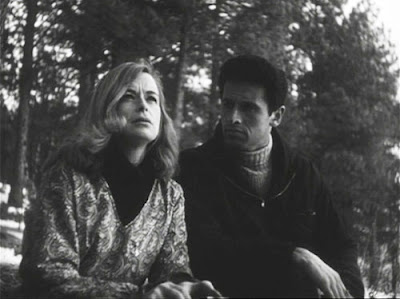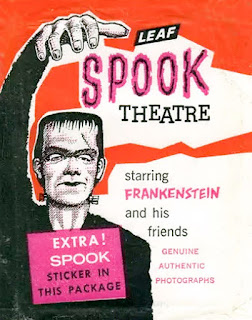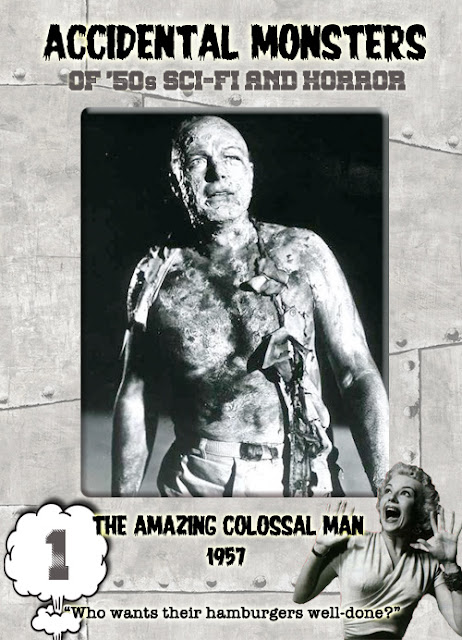Now Playing: Beast from Haunted Cave (1959)
Pros: The mash-up of crime-thriller, sci-fi and horror genres works surprisingly well; A couple of the actors shine with the snappy, noirish dialog; The creature concept is unique and eerie.
Cons: The crooks’ “brilliant” heist seems particularly looney; Makes you wonder what might have been if the budget had been a tad bigger.
When I first saw From Dusk Till Dawn (1996), I remember thinking how clever it was of the filmmakers to get things all revved up with what looked like a hard-charging crime-action-thriller, then, like a crazy cab ride in Hell, take a hard turn down a dark and bloody horror detour.
If you don’t like getting whiplash from colliding genres, then you probably don’t seek out movies like that in the first place. However, enough people were intrigued rather than annoyed by the bait-and-switch that the film did decent box office and went on to become a legitimate cult favorite. And of course, director
Robert Rodriquez and screenwriter (and actor)
Quentin Tarantino would become kings of genre filmmaking.
Kings usually owe their positions to their forebears, and Rodriquez and Tarantino are no different. Tarantino in particular is an unashamed B/exploitation flick nerd-geek, and has made a wildly successful living mining vintage sleaze for films that, love ‘em or not, are like nothing else coming out of Hollywood. As he
famously said in a 1994 interview, “I steal from every movie ever made… Great artists steal, they don’t do homages.” Ironically, Tarantino’s stealing from earlier film eras makes his films seem wildly original compared to the endless stream of remakes, reboots and CGI-infused comic book movies the industry spews out.
 |
"It's okay George, your career is going to be fine after this.
Just take the money and buy something nice for yourself." |
I doubt that
Beast from Haunted Cave (1959) was a direct influence on Tarantino, but who knows?
Beast certainly shares a good bit of celluloid DNA with
From Dusk Till Dawn: a criminal gang escapes into the remote countryside after a big heist, only to jump from the frying pan into the fire as they encounter a horrific, bloodthirsty creature that wreaks the ultimate Karmic justice.
I know I sound like a broken record, but
Beast from Haunted Cave is yet another creature feature that had a big impact on me when I was a kid. I first encountered
Beast at the bowling alley, of all places, when I was about 10 years old. My parents bowled in a Friday night league, and instead of getting a babysitter they often took me along.
That was okay by me, because the bowling alley had a lounge with a TV. The lounge was usually empty, so it became my TV den away from home. Better yet, there was a creature feature show that aired on Friday nights, so I was in heaven with the movie and a soda and candy from the machine.
The Friday night show specialized in ‘50s and ‘60s sci-fi like
Earth vs. the Flying Saucers,
Killers from Space, and the early Roger Corman cheapies. I remember being excited on one of those bowling league nights about seeing
Beast from Haunted Cave for the first time. But the excitement dissipated when it started out looking like some boring crime caper, with jaded adults snarling and shouting and roughing each other up.
CAUTION: SPOILERS HIDING IN THE SHADOWS AHEAD, WAITING TO JUMP OUT AT YOU!
 |
Even more frightening than the Beast from Haunted Cave:
shoes you share with hundreds of other people! |
I managed to stick with it long enough to get a jolt. It was a scene in which a character investigates weird cries in the night, and shines his flashlight on a gaunt, spectral-looking woman, half-conscious, who is wrapped in a huge web and suspended in a tree.
That got my attention. I remember checking in a lot with my parents the rest of the evening, which was not my usual practice, and I slept pretty fitfully that night. Like any resilient Monster Kid, the next time
Beast aired I made sure to catch it, determined to see it all the way through. I enjoyed it well enough, making allowances for the boring crime caper parts, but I also remember ultimately being disappointed with the monster, which seemed spindly and slow and not very scary.
But man, it was the monster’s
work that was the scary part. I’d not seen anything quite like it up to that point: humans pinned against trees or cave walls by giant webs, weakly crying for help as the thing lumbers toward them.
I didn’t have a word for it back then, but having recently watched
Beast again, “uncanny” fits nicely. It’s the kind of feeling that some phobic people get when they just think about big, fat spiders (not to mention human-sized ones). It’s also on par with the dread generated by the shock ending of the original
The Fly (but done with a fraction of that film’s budget).
 |
| It suddenly dawned on Natalie that she had forgotten to get bug spray at the store. |
Experiencing it again with adult sensibilities, I have a better appreciation for the “boring” heist sequences. Like Rodriquez’s and Tarantino’s hybrid horror-thriller, the juxtaposition of gangsters with a whole ‘nother level of otherworldly evil serves to sharpen the suspense, keeps the viewer guessing, and even draws a little extra humanity out of criminal characters that might otherwise be all-too-familiar cardboard cutouts.
Beast’s odd coupling of genres was apparently born more out of economical improvisation than artistic inspiration. Always looking to shoot pictures as quickly and cheaply as possible and tired of their usual locations in southern California, producers
Roger Corman and brother
Gene arranged with the town of Deadwood, South Dakota, for some picturesque winter location shooting. To get the most for their travel money, they planned to shoot two pictures there back-to-back using the same cast and crew:
Beast, a horror quickie, and
Ski Troop Attack, a lower-than-low-budget war picture.
Even the story was recycled. Roger’s go-to screenwriter
Charles B. Griffith dusted off an old script from an earlier gangster/heist potboiler (
Naked Paradise, 1957), added a monster, and bam, they were good to go. (Griffith scripted the best known of Roger Corman’s early cult favorites, including
Not of This Earth, Attack of the Crab Monsters,
A Bucket of Blood, and
The Little Shop of Horrors.)
At the core of Griffith’s recycled plot is a tension-filled love triangle that develops when a gang pulls off a heist and enlists an innocent, unsuspecting third party to help them make their escape. In
Naked Paradise (with its tropical island setting), the dupe is a for-hire boat captain (played by
Richard Denning). In
Beast, the gang hires lodge owner and outdoorsman Gil Jackson (
Michael Forest) to lead them in a cross-country ski trek to a cabin where, unbeknownst to Gil, they plan to be picked up by a bush plane.
Naturally, complications ensue for the gang. First, when they set off an explosion in a nearby mine to divert attention while they clean out the mining company's stash of gold bars, the blast awakens a prehistoric monster that is royally pissed that its lair has been blown up. The creature proceeds to stalk the gang as they take off for the remote cabin. (To add insult to injury, the criminal geniuses don’t seem to have considered how hard it is to lug heavy gold bars cross-country on skis, or how quickly the weather can change in South Dakota hill country.)
 |
| "So Marty, how many bars have you got? No, not on your phone you idiot!" |
Second, the gang leader’s moll, Gypsy (
Sheila Noonan), becomes mightily disillusioned with her vicious, self-absorbed boyfriend (
Frank Wolff) as she falls for the hunky, free-spirited Gil. Both complications eventually converge to create the perfect storm at the film’s conclusion.
It’s tempting to say there’s something for everyone in
Beast -- snappy, noirish dialog and a tense love triangle for the adults, and a blood-sucking humanoid spider-fly creature for the kids. Conversely, there’s plenty for either audience segment to be bored with. The latter seems to have been the prevailing reaction, as, in spite of its wide release on DVD and streaming platforms,
Beast has never been a nostalgic favorite like
Attack of the Crab Monsters or
Little Shop of Horrors.
Re-visiting
Beast after a couple of decades or more, it occurred to me that, absent the monster, this could have been a decent little low-budget noir. Certainly screenwriter Griffith had an ear for Chandleresque dialog. Take for example this exchange between Gypsy and Alexander at the lodge’s tavern:
Gypsy (commenting on the other bar patrons): "Look at all the happy little people enjoying their freedom. Dosey doe and round we go."
Alexander (looking peeved): "What kind of freedom is that? They’re all tied down to their petty futures."
Gypsy: "It might be nice to have a future, even a petty little one."
When he’s not being vicious and controlling, we see flashes of what attracted Gypsy to Alexander. He knows what he wants, wears cool shades indoors, and his cynicism could easily be confused with sophistication by naive young women.
 |
| Alexander smokes, drinks and wears his sunglasses at night. |
But once Gypsy has gotten a taste of Gil’s life of the great outdoors, fresh air, and true freedom to do as you please, Alexander’s constricted, bitter life of never being satisfied, endlessly moving around and endlessly planning the next big job, looks a lot less attractive.
Rather than undercutting Gypsy’s poignant story, the addition of the beast punctuates it. Gil’s great outdoors contains more things than are dreamt of in a gangster’s philosophy, including weird bloodsucking monsters that get coughed up from the bowels of the earth by ill-considered explosive charges. Next to such ancient evil, Alexander looks petty and small. It’s fitting that, while the local authorities are apparently powerless to apprehend the crooks, Nature is there to step in and deliver ultimate justice.
If you’re willing to keep an open mind and not judge it by contemporary special effects standards (and if you’re reading this, you’re no doubt very open minded), then the beast does have some effectively eerie moments delivering Nature’s justice (and admittedly, a few that don’t work so well). It certainly is unlike anything else in sci-fi/horror before or since.
In his epic survey of American sci-fi films of the ‘50s and early ‘60s,
Keep Watching the Skies! (McFarland, 1986), Bill Warren recounts how the Beast was born:
“[T]he beast, which he [actor and special effects artist Chris Robinson] called ‘Humphrass,’ … was seven feet tall with eleven-foot arms. He based the design on that of an insect he discovered in a book on unusual animals, the wingless hanging fly. ‘To one plywood base, I added a thin aluminum stripping to create the skeletal form. I then covered the skeleton over with chicken wire. After that I wrapped it in sheets and muslin, sort of like I was making a mummy. … The head was fashioned out of quarter-inch aluminum wire, with steel wrapped around that and then once again in muslin, forming a sort of shroud…’ Robinson completed Humphrass by adding spun glass to give it an appropriately cobwebby appearance.” [Warren, p. 233]
While Warren acknowledges that the beast is “not realistic,” he does call it “eerie and unusual” and singles out the scene that had such an impact on me as a kid:
“The film, in fact, has one great shudder scene, the shot of Natalie, encased in webbing, opening her eyes. Our first glimpse of her has a peculiar impact; it’s so unexpected that you have a hard time adjusting to what you are seeing. And the image is beautiful. About the time you recognize it as a corpse caught in the branches, the ‘corpse’ opens her eyes. It’s an imaginative, almost poetic moment, at once both conventional and unusual, like the film itself.” [Ibid., p. 234]
 |
| This beautiful, poetic moment scared the crap out of me when I was a kid. |
Getting back to the human characters, Sheila Noonan (credited in the film as Sheila Carol), is especially good as Gypsy, whose character, fittingly for her name, has been wandering around for too long in the criminal underworld, clinging to a sociopath incapable of love. Surprisingly, Noonan only appeared in a handful of films --
Beast,
Ski Troop Attack,
A Bucket of Blood (with the inimitable
Dick Miller),
The Incredible Petrified World (a stinker with
John Carradine) -- and a single episode of
Gunsmoke; all between 1957 and 1960.
Michael Forest as Gil is as wooden as a tree (pun intended), but then, as a buff icon representing clean living and the complete antithesis of Alexander’s urban decadence, nothing more is really required of him. In contrast to Noonan’s brief career, Forest, born in 1929, is still acting today (!!), with literally hundreds of credits and a new film slated for this year. Fans of vintage sci-fi TV may remember his stints on the original
Outer Limits,
Twilight Zone, and
Star Trek series.
The third member of the triangle, Frank Wolff as Alexander the gang leader, brings just enough cynical humanity to the role to make it conceivable that Gypsy might have once had a thing for him, regardless of the character’s disregard for human life. Wolff got his start in films doing the two South Dakota shoots (
Beast and
Ski Troop Attack) and
Atlas (Corman’s mediocre attempt at sword and sandal), but in the early ‘60s he moved to Europe and racked up a considerable number of credits in low-budget potboilers, especially spaghetti westerns. Tragically, he committed suicide in 1971.
 |
| "Hey Gypsy, I'll bet you didn't know that many parts of a pine tree are edible!" |
Beast was
Monte Hellman’s first directing job (Gene Corman is credited as Producer and Roger as Executive Producer). Unlike other directors who got their starts with Roger Corman (e.g., Joe Dante, Francis Ford Coppola, and Ron Howard), Hellman never managed to break into the big time, but he does have the distinction of having directed Jack Nicholson (pre-superstardom) in five films; two westerns (
The Shooting,
Ride in the Whirlwind), a war picture (
Back Door to Hell), a crime-thriller (
Flight to Fury), and a horror picture (
The Terror; he was one of seven credited directors to take part in that chaotic production).
Beast deserves more of a cult reputation than it’s gotten over the years. To echo Bill Warren, it is one of the more unusual “conventional” sci-fi/horror pics of the 1950s, and includes one eerie scene that is almost “beautiful” in its frightfulness. Add Charles B. Griffith’s stylishly noir dialog and an unconventional love triangle, and you’ve got a B picture that is much more than the sum of its economical parts.
Where to find it: Thankfully, you can throw a stone in any direction and likely hit a
DVD copy or a
stream.
Coming Soon: More crooks vs. creatures mayhem as a gang of kidnappers do battle with a beautiful but deadly alien in
The Astounding She-Monster (1957)!





















